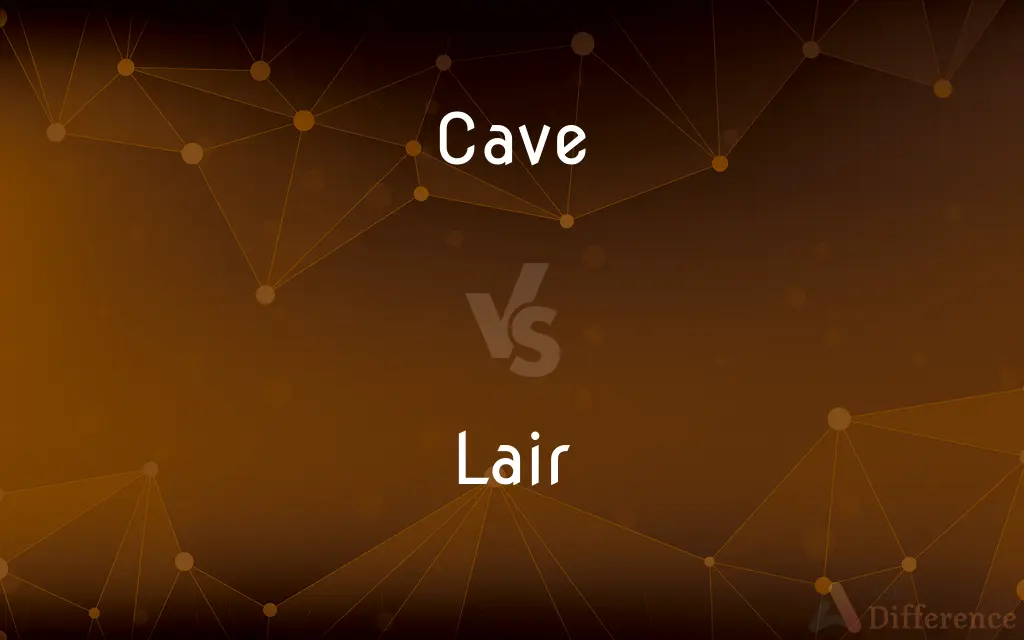Cave vs. Lair — What's the Difference?
Edited by Tayyaba Rehman — By Maham Liaqat — Updated on March 14, 2024
A cave is a natural underground space, large enough for a human to enter, while a lair refers specifically to the dwelling or hideout of a wild animal.

Difference Between Cave and Lair
Table of Contents
ADVERTISEMENT
Key Differences
Caves are naturally occurring spaces beneath the earth's surface, formed by geological processes such as erosion, lava tubes, or dissolution of rock. They can vary greatly in size and complexity and are explored for scientific, recreational, and historical interests. In contrast, a lair is a term used to describe the den or resting place of a wild animal, which can be located in caves but also in other secluded places like thickets or underwater.
The concept of a cave is primarily defined by its physical and geological characteristics, including its formation, type of rock, and internal features such as stalactites and stalagmites. On the other hand, a lair is defined by its use by an animal, often as a safe space for sleeping, rearing young, or as a refuge from predators.
Caves have played significant roles in human history as sites of habitation, ritual, and art, evidenced by cave paintings and artifacts. Lairs, while occasionally used by humans for various purposes, are more commonly associated with the natural behaviors and habitats of animals, including bears, lions, and wolves.
The study of caves, known as speleology, encompasses a wide range of scientific disciplines, including geology, biology, and archaeology, highlighting their importance in understanding Earth's history and biodiversity. The study of lairs, while not a distinct scientific field, contributes to ethology and ecology by offering insights into animal behavior and their interactions with the environment.
While caves can be found worldwide, varying from shallow caverns to deep and extensive cave systems, lairs are specifically chosen or created by animals based on their survival needs, often reflecting the ecology of the region and the habits of the species.
ADVERTISEMENT
Comparison Chart
Definition
A natural underground space large enough for a human to enter.
The dwelling or hideout of a wild animal.
Formation
Formed through geological processes.
Chosen or created by animals for shelter or protection.
Associated With
Geological features, historical sites, and recreational exploration.
Animal behavior, habitat, and survival strategies.
Study
Speleology involves the study of caves.
Studied within ethology and ecology as part of animal behavior.
Examples
Limestone caves, ice caves, volcanic caves.
Dens, nests, burrows, under rocks, within thickets or caves.
Human Connection
Used historically for shelter, rituals, and art.
Used metaphorically to describe human hideouts or retreats.
Importance
Important for understanding Earth’s history and biodiversity.
Provides insight into animal behavior and ecological interactions.
Compare with Definitions
Cave
A natural underground space formed by geological activity.
The Mammoth Cave is known for its extensive network of passages.
Lair
A hideout for wild animals, often for shelter or raising young.
The lioness returned to her lair with food for her cubs.
Cave
Explored for recreational, scientific, and educational purposes.
Cave diving in the Yucatan Peninsula uncovers hidden underwater caves.
Lair
The term is sometimes used metaphorically for human hideouts.
The abandoned warehouse became a lair for the fugitives.
Cave
Varied in formation, including limestone, volcanic, and ice caves.
The ice caves of Iceland are formed within glaciers.
Lair
Reflects the survival strategies and behaviors of animals.
Foxes dig burrows to serve as cozy lairs for the winter.
Cave
Often serves as a habitat for unique cave-dwelling species.
The blind fish in Mexican caves have adapted to total darkness.
Lair
Studied to understand animal ecology and behavior.
The bear's lair was studied to learn about hibernation patterns.
Cave
A place of historical significance and exploration.
Lascaux Cave in France features prehistoric cave paintings.
Lair
Can be found in caves, thickets, or underwater.
Otters often build their lairs close to water sources.
Cave
A cave or cavern is a natural void in the ground, specifically a space large enough for a human to enter. Caves often form by the weathering of rock and often extend deep underground.
Lair
The den or dwelling of a wild animal.
Cave
A natural underground chamber in a hillside or cliff
The narrow gorge contains a series of prehistoric caves
Lair
A den or hideaway.
Cave
Explore caves as a sport
They say they cave for the adventure, challenge, and physical exercise
Lair
(Obsolete) A resting place; a couch.
Cave
Capitulate or submit under pressure; cave in
He caved because his position had become untenable
She finally caved in the face of his persistence
Lair
A place inhabited by a wild animal, often a cave or a hole in the ground.
Cave
(among children) look out!
Lair
A shed or shelter for domestic animals.
Cave
A hollow or natural passage under or into the earth, especially one with an opening to the surface.
Lair
(figuratively) A place inhabited by a criminal or criminals, a superhero or a supervillain; a refuge, retreat, haven or hideaway.
Cave
A storage cellar, especially for wine.
Lair
A bed or resting place.
Cave
To dig or hollow out.
Lair
(Scotland) A grave; a cemetery plot.
Cave
To cause to collapse or fall in. Often used with in
The impact caved in the roof of the car.
Lair
(Scotland) A bog; a mire.
Cave
To fall in; collapse. Often used with in
The walls caved in during the earthquake.
Lair
A person who dresses in a showy but tasteless manner and behaves in a vulgar and conceited way; a show-off.
Cave
To give up all opposition; yield. Often used with in
The school committee caved in to the demands of parents.
Lair
(Britain) To rest; to dwell.
Cave
To explore caves.
Lair
(Britain) To lay down.
Cave
A large, naturally-occurring cavity formed underground or in the face of a cliff or a hillside.
We found a cave on the mountainside where we could take shelter.
Lair
(Britain) To bury.
Cave
A hole, depression, or gap in earth or rock, whether natural or man-made.
Lair
To mire.
Cave
A storage cellar, especially for wine or cheese.
This wine has been aged in our cave for thirty years.
Lair
To become mired.
Cave
A place of retreat, such as a man cave.
My room was a cozy cave where I could escape from my family.
Lair
A place in which to lie or rest; especially, the bed or couch of a wild beast.
Cave
(nuclear physics) A shielded area where nuclear experiments can be carried out.
Lair
A burying place.
Cave
Debris, particularly broken rock, which falls into a drill hole and interferes with drilling.
Lair
A pasture; sometimes, food.
Cave
(mining) A collapse or cave-in.
Lair
The habitation of wild animals
Cave
The vagina.
Cave
A group that breaks from a larger political party or faction on a particular issue.
Cave
(obsolete) Any hollow place, or part; a cavity.
Cave
(programming) A code cave.
Cave
To surrender.
He caved under pressure.
Cave
To collapse.
First the braces buckled, then the roof began to cave, then we ran.
Cave
To hollow out or undermine.
The levee has been severely caved by the river current.
Cave
To engage in the recreational exploration of caves.
I have caved from Yugoslavia to Kentucky.
Let's go caving this weekend.
Cave
(mining) In room-and-pillar mining, to extract a deposit of rock by breaking down a pillar which had been holding it in place.
The deposit is caved by knocking out the posts.
Cave
To work over tailings to dress small pieces of marketable ore.
Cave
(obsolete) To dwell in a cave.
Cave
Look out!; beware!
Cave
A hollow place in the earth, either natural or artificial; a subterraneous cavity; a cavern; a den.
Cave
Any hollow place, or part; a cavity.
Cave
A coalition or group of seceders from a political party, as from the Liberal party in England in 1866. See Adullam, Cave of, in the Dictionary of Noted Names in Fiction.
Cave
To make hollow; to scoop out.
The mouldred earth cav'd the banke.
Cave
To dwell in a cave.
Cave
To fall in or down; as, the sand bank caved. Hence (Slang), to retreat from a position; to give way; to yield in a disputed matter.
Cave
An underground enclosure with access from the surface of the ground or from the sea
Cave
Hollow out as if making a cave or opening;
The river was caving the banks
Cave
Explore natural caves
Common Curiosities
Can a cave be a lair?
Yes, a cave can serve as a lair for animals, but lairs can also be located in other secluded spots beyond caves.
Why are caves important?
Caves are important for scientific research, recreational exploration, and understanding Earth's history and biodiversity.
How do animals choose their lairs?
Animals choose lairs based on factors like safety, proximity to food sources, and suitability for rearing young, reflecting their survival strategies and behaviors.
How are caves and lairs different?
Caves are defined by their geological formation and physical characteristics, while lairs are specific to the animal use of a sheltered space for protection or habitation.
What is a cave?
A cave is a natural underground space, large enough for humans to enter, formed by geological processes.
What can we learn from studying lairs?
Studying lairs offers insights into animal behavior, survival strategies, and how animals interact with their environment.
What is a lair?
A lair refers to the dwelling or hideout of a wild animal, often used for shelter, safety, and rearing young.
What is the significance of lairs in animal conservation?
Understanding the location and structure of animal lairs is important in conservation efforts, as it helps protect critical habitats, especially for endangered species. Conservation strategies often include preserving these habitats to ensure the survival of specific animal populations.
Are all caves naturally formed?
Yes, caves are naturally formed through various geological processes, such as erosion, dissolution of rock, or volcanic activity.
Can humans live in caves or use them as lairs?
Historically, humans have used caves as shelter, for rituals, or as defensive hideouts. While modern humans generally do not live in caves, they are still used for scientific research, conservation efforts, and recreational exploration.
What types of animals typically have lairs?
Many types of animals have lairs, including mammals like bears, lions, and foxes, as well as some birds, reptiles, and aquatic animals. The specific nature of the lair depends on the animal's ecological needs and behaviors.
How do speleologists study caves?
Speleologists study caves through a combination of field exploration, mapping, and analyzing geological formations. They also study cave ecosystems, including the unique flora and fauna adapted to cave environments.
What role do caves play in ecosystems?
Caves play crucial roles in ecosystems by providing habitats for specialized cave-dwelling organisms, serving as water reservoirs, and contributing to the geological process of karst formation, which affects landscapes and water systems.
Share Your Discovery

Previous Comparison
Fill vs. Occupy
Next Comparison
Vertuous vs. VirtuousAuthor Spotlight
Written by
Maham LiaqatEdited by
Tayyaba RehmanTayyaba Rehman is a distinguished writer, currently serving as a primary contributor to askdifference.com. As a researcher in semantics and etymology, Tayyaba's passion for the complexity of languages and their distinctions has found a perfect home on the platform. Tayyaba delves into the intricacies of language, distinguishing between commonly confused words and phrases, thereby providing clarity for readers worldwide.













































